The performance of a digital communication system is quantified by the probability of bit detection errors in the presence of thermal noise. In the context of wireless communications, the main source of thermal noise is addition of random signals arising from the vibration of atoms in the receiver electronics.
You can also watch the video below.
The term additive white Gaussian noise (AWGN) originates due to the following reasons:
- [Additive] The noise is additive, i.e., the received signal is equal to the transmitted signal plus noise. This gives the most widely used equality in communication systems.
\begin{equation}\label{eqIntroductionAWGNadditive}
r(t) = s(t) + w(t)
\end{equation}
which is shown in the figure below. Moreover, this noise is statistically independent of the signal. Remember that the above equation is highly simplified due to neglecting every single imperfection a Tx signal encounters, except the noise itself.
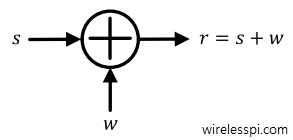
- [White] Just like the white colour which is composed of all frequencies in the visible spectrum, white noise refers to the idea that it has uniform power across the whole frequency band. As a consequence, the Power Spectral Density (PSD) of white noise is constant for all frequencies ranging from $-\infty$ to $+\infty$, as shown in Figure below.

Nyquist investigated the properties of thermal noise and showed that its power spectral density is equal to $k \times T$, where $k$ is a constant and $T$ is the temperature in Kelvin. As a consequence, the noise power is directly proportional to the equivalent temperature at the receiver frontend and hence the name thermal noise. Historically, this constant value indicated in Figure above is denoted as $N_0/2$ Watts/Hz.
When we view the constant spectral density (we do not discuss random sequences here, so this discussion is just for a general understanding) as a rectangular sequence, its iDFT must be a unit impulse. Furthermore, we saw that the iDFT of the spectral density is the auto-correlation function of the signal. Combining these two facts, an implication of a constant spectral density is that the auto-correlation of the noise in time domain is a unit impulse, i.e., it is zero for all non-zero time shifts. This is drawn in the figure below.

In words, each noise sample in a sequence is uncorrelated with every other noise sample in the same sequence. Therefore, mean value of a white noise is zero.
- [Gaussian] The probability distribution of the noise samples is Gaussian with a zero mean, i.e., in time domain, the samples can acquire both positive and negative values and in addition, the values close to zero have a higher chance of occurrence while the values far away from zero are less likely to appear. This is shown in the figure below. As a result, the time domain average of a large number of noise samples is equal to zero.
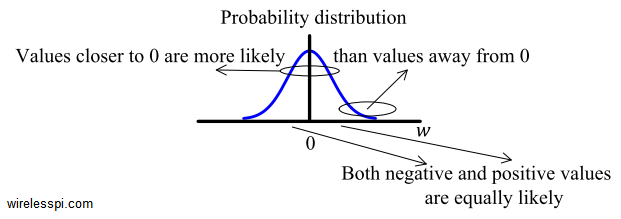
In reality, the ideal flat spectrum from $-\infty$ to $+\infty$ is true for frequencies of interest in wireless communications (a few kHz to hundreds of GHz) but not for higher frequencies. Nevertheless, every wireless communication system involves filtering that removes most of the noise energy outside the spectral band occupied by our desired signal. Consequently, after filtering, it is not possible to distinguish whether the spectrum was ideally flat or partially flat outside the band of interest. To help in mathematical analysis of the underlying waveforms resulting in closed-form expressions — a holy grail of communication theory — it can be assumed to be flat before filtering.
For a discrete signal with sampling rate $F_S$, the sampling theorem dictates that the bandwidth of a signal is constrained by a lowpass filter within the range $\pm F_S/2$ to avoid aliasing. For the purpose of calculations, this filter is an ideal lowpass filter with
\begin{equation*}
H(F) =
\begin{cases}
1 & -F_S/2 < F < +F_S/2 \\
0 & \text{elsewhere}
\end{cases}
\end{equation*}
The resulting in-band power is shown in red in the figure below, while the rest is filtered out.
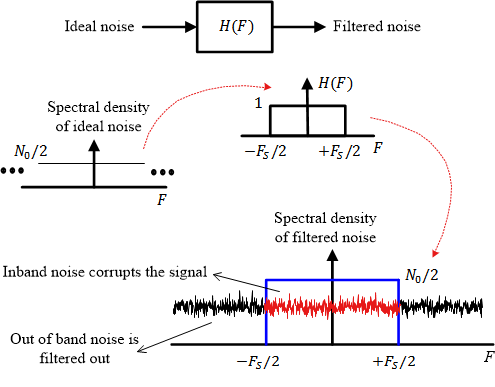
As with all densities, the value $N_0$ is the amount of noise power $P_w$ per unit bandwidth $B$.
\begin{equation}\label{eqIntroductionNoisePower1}
N_0 = \frac{P_w}{B}
\end{equation}
For the case of real sampling, we can plug $B=F_S/2$ in the above equation and the noise power in a sampled bandlimited system is given as
P_w = N_0\cdot \frac{F_S}{2} \label{eqIntroductionNoisePower2}
\end{equation}
Thus, the noise power is directly proportional to the system bandwidth at the sampling stage.
As we will see in other articles, a communication signal has a lot of structure in its construction. However, due to Gaussian nature of noise acquiring both positive and negative values, the result of adding a large number of noise-only samples tends to zero.
\begin{equation*}
\sum _n w[n] \rightarrow 0 \qquad \text{for large}~ n
\end{equation*}
Therefore, when a noisy signal is received, the Rx exploits this structure through correlating with what is expected. In the process, it estimates various unknown parameters and detects the actual message through averaging over a large number of observations. This correlation brings the order out while averaging drives the noise towards zero.
An AWGN channel is the most basic model of a communication system. Some examples of systems operating largely in AWGN conditions are space communications with highly directional antennas and some point-to-point microwave links. While several imperfections are still present (e.g., carrier and timing offsets), the underlying signal structure stays intact leading to a simpler Rx design because no channel equalizer needs to be incorporated.





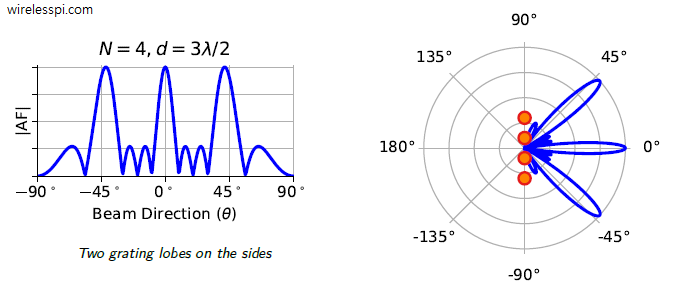

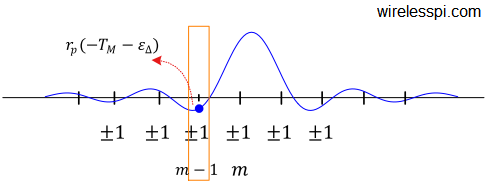
Nice & quality information about AWGN. Very useful for Electronics student & PG students also. Thanks again for information.
Thanks Monali. Glad you liked it.
Even My teacher wasn’t explain this properly thx for such wonderful piece of knowledge.
Thank you.
nice explanation very helpful
I love the way it is explained (like for instance the interpretation of the unit pulse autocorrelation). Thanks!
How is PSD=k*T….it should be
PSD=k*B
It is the noise power spectral density which is directly proportional to the equivalent temperature at the receiver frontend. Multiply with $B$ (the bandwidth) to find the actual noise power.
For example, as of 2019, Australia’s population density (the number of people per unit area) is $\pi$ people/$\text{km}^2$ and its area is 7.692 million $\text{km}^2$. From here, you can easily get the actual Australian population.
what Actual value Additive White Gaussian Noise (AWGN)…?
Since it is a random process, we talk about it in a statistical manner. The actual values vary for each sample sequence.
how the power noise inside the bandwidth between 0 and Fs/2 will be removed ? i did not understand this part enough
The noise power inside the desired bandwidth cannot be removed. This is a constraint set by nature.
If a discrete time signal(sequence) is corrupted by AWGN,then how can we derive the actual signal(sequence) after corruption?
If it is a digitally modulated communication signal, you should read about the minimum distance rule. The underlying intuition is that AWGN having a Gaussian distribution has a squared distance in its exponent with a negative sign. Hence, the maximum is achieved through minimizing the distance between the received and target constellation points.
Classify thermal noise as Energy or Power Signal. Justify your answer with mathematical proof.
Very well explained.
Thanks
Very useful information, thanks.
Explicit, concise and educative
Thanks!
My Teacher is an Elitist Bhramin. We need to make a filter that make his voice more audible, do you have any suggestions on how to make it?
Thank you
Interesting question. Maybe schedule the class in a room with a good sound system and have him use a wireless mic.
Hi Qasim, Why is it that $B = Fs/2$? why not $B$ be system BW, then $F_s$ can be anything $\ge 2B$. I think that $B$ is the system BW and $F_s$ can be $\ge 2B$. For GPS say $B = 31$ Mhz, then minimum $F_s = 62$ MHz. Also, one can have $F_s$ as 100 MHz too. The higher the $F_s$, the lesser is the noise (quantization), right!
Thanks for the tutorial Sir, wondeful contribution.
babul.
There is a difference between real and complex sampling, see the I/Q signals tutorial.